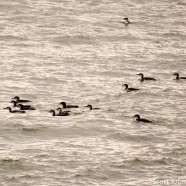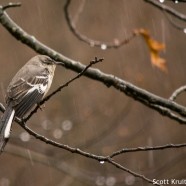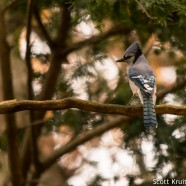Grassland Migrants
Yesterday I was able to enjoy and photograph a couple of uncommon grassland birds for us in the Northeast – the Dickcissel (Spiza americana) and the Grasshopper Sparrow (Ammodramus savannarum). Both of these species had been spotted at Stratford Point where they are almost annual visitors, with Dickcissels typically stopping over in the fall and Grasshopper Sparrows being seen sometimes in both spring and autumn. I decided to take a walk around the site with my friend and great birder Tom Murray as we were giving the sparrows some space in hopes the unseen Grasshopper would pop back...
Read MoreGrasshopper Sparrow
I photographed this Grasshopper Sparrow (Ammodramus savannarum) last week on a dreary and foggy morning in grasslands known to be a spring migratory site for the species. It was busy feeding in the mist, generally avoiding any picturesque views, as is typical for the species. It had even been singing the previous day! RTPI staff documented confirmed breeding of Henslow’s Sparrows and Grasshopper Sparrows at the Chautauqua County/Jamestown Airport (KJHW) during the summer of 2013. Both species are listed as New York endangered species with the Henslow’s Sparrow classified as ‘threatened’ and...
Read MoreCommon Loons (Gavia immer)
There have been sizable groups of Common Loons (Gavia immer), with a few Red-throated Loons (Gavia stellata) occasionally mixed in, off Stratford, Connecticut lately. The waters of Long Island Sound have been a feeding frenzy for the species during this period with prolonged below-average temperatures, and some flocks like this have moved close to shore to dive for meals. On a dark and dreary day their grays blend in wonderfully with the water, making for exceptional camouflage. Scott Kruitbosch Conservation & Outreach Coordinator
Read MoreWet Mockingbird
I don’t know what a forlorn bird looks like but I think it is something close to this Northern Mockingbird thanks to some wet, cold, and dreary weather. Personally I love our four seasons and embrace the rotation of life they feature all around us. I wonder if birds like this one know spring is only a few months away… Scott Kruitbosch Conservation & Outreach Coordinator
Read MoreDull Blue Jay under lack of sunlight
I took this photo of a Blue Jay under very cloudy, dark and dreary conditions as a comparative example to the bird that I previously photographed and posted that was in full sunlight. See, when there is considerably less light the species appears far less blue because it is all an illusion of sorts. Missing out on the vibrant shades of some species during overcast conditions is not a deception of our eyes – the colors are just not there! Those tricky birds… Scott Kruitbosch Conservation & Outreach Coordinator
Read More








